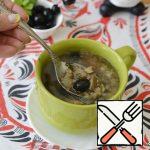Broth with dissolved miso paste should not be boiled. Adjust the taste with soy sauce.
In serving plates, arrange tofu cubes, mushrooms, wakame seaweed squeezed from excess moisture, soy sprouts for texture. Pour in the broth. Sprinkle the soup with green onions on top and, if desired, add a little hot pepper.
Everyone knows the benefits of fermented foods. In all world cuisines, there are recipes for fermented dishes: sauerkraut, kumis, kombucha, yogurt, kimchi, ayran, etc.
Miso paste is a traditional Japanese seasoning, which is a thick paste made from soybeans that have been fermented with salt, and koji yeast.
in 1945.
 Easy Soup “Protein charge” Recipe
Easy Soup “Protein charge” Recipe
 Vegetable Soup “Fitness” Recipe
Vegetable Soup “Fitness” Recipe
 Vietnamese Soup “Pho Hai San” Recipe
Vietnamese Soup “Pho Hai San” Recipe
 Ear in Finnish with Pink Salmon Recipe
Ear in Finnish with Pink Salmon Recipe
 Soup with Funchoza and Shrimp Recipe
Soup with Funchoza and Shrimp Recipe
 Lean Buckwheat Soup with Mushrooms Recipe
Lean Buckwheat Soup with Mushrooms Recipe
 Soup-Puree “Two Peas per Spoon” Recipe
Soup-Puree “Two Peas per Spoon” Recipe
 Rustic Soup with Potatoes Recipe
Rustic Soup with Potatoes Recipe
 Bean and Fried Vegetable Soup Recipe
Bean and Fried Vegetable Soup Recipe
 Soup with Peas and Cauliflower Recipe
Soup with Peas and Cauliflower Recipe
 Soup with Buttered Garlic Dumplings Recipe
Soup with Buttered Garlic Dumplings Recipe
 Rice Soup with Lamb and Daikon Recipe
Rice Soup with Lamb and Daikon Recipe